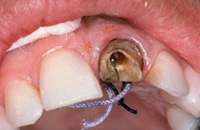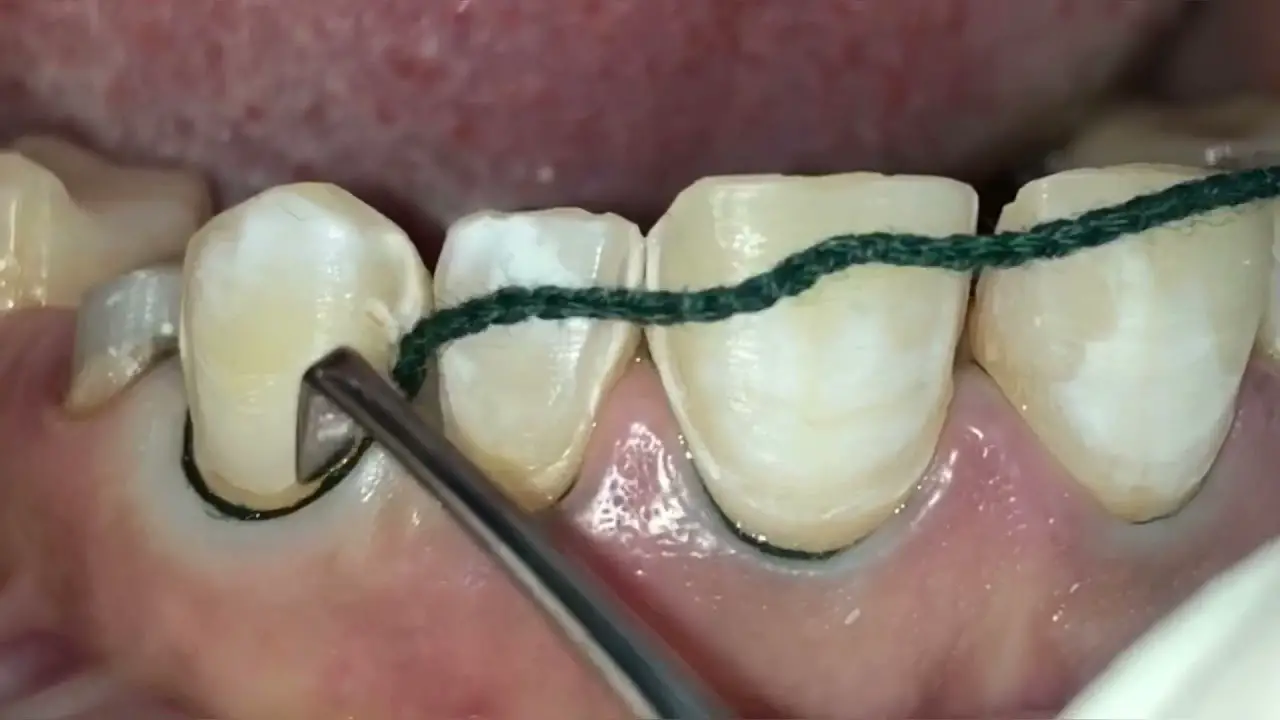Leaving the retraction cord in the gums can lead to damage to the attachment epithelium, gingival recession, gingival pockets, localized alveolar bone loss, postoperative discomfort, and gingival recession. It may also cause a periodontal abscess if left in place.
Dentists use retraction cords to achieve good retraction in the sulcus before taking impressions, but it is important to remove them promptly to prevent complications. Forgetting to remove the retraction cord can potentially cause issues for the patient, so it is essential to ensure it is taken out after use.

Credit: www.dentistrytoday.com
The Risks Of Leaving Retraction Cord For Extended Time
Leaving the retraction cord in for an extended time can have negative consequences, including damage to the gingiva, postoperative discomfort, and gingival recession. It is important to remove the cord before taking an impression to avoid these risks.
Leaving retraction cord for an extended period of time can have detrimental effects on the gingival tissue and oral health. In this section, we will explore the risks associated with leaving retraction cord in place for too long.
Damage To Gingival Attachment Epithelium:
Leaving retraction cord for an extended time can damage the attachment epithelium within the sulcular gingival complex. This can result in the violation of the biological width, leading to several adverse effects such as:
- Gingival recession: Prolonged contact with retraction cord can cause the gum tissue to recede, exposing the root surface of the tooth.
- Gingival pockets: Retraction cord left for too long can create pockets in the gum tissue, which can potentially trap food debris and bacteria, increasing the risk of gum disease.
- Localized alveolar bone loss: Continuous exposure of the gingival tissue to retraction cord can lead to bone loss around the affected tooth.
Consequences Of Leaving Retraction Cord For Extended Time:
Leaving retraction cord in place for an extended period can lead to the following consequences:
- Discomfort and pain: Prolonged contact with the cord can cause discomfort and pain for the patient.
- Delayed healing: The presence of retraction cord for an extended time can delay the healing process of the gingival tissue.
- Increased risk of infection: Extended exposure to retraction cord can increase the risk of infection in the affected area.
- Compromised oral health: Leaving retraction cord for an extended period can compromise the overall oral health of the patient, leading to further complications.
It is important for dental professionals to closely monitor the use of retraction cord and ensure that it is not left in place for longer than necessary. Regular evaluation of the gingival tissue is crucial to detect any signs of damage or adverse effects caused by the retraction cord.
Leaving retraction cord for an extended time can result in damage to the gingival attachment epithelium, gingival recession, gingival pockets, and localized alveolar bone loss. Therefore, it is essential to follow proper protocols and remove the retraction cord within the recommended time frame to minimize the risks associated with its prolonged use.
How Long Can You Leave Retraction Cord?
Leaving the retraction cord in for too long can result in gingival recession, pockets, and bone loss. It may also cause postoperative discomfort and damage to the gingiva, so it’s important to remove it before taking impressions.
Duration Of Retraction Cord Placement:
- The duration for which a retraction cord can be left in place depends on various factors, including the specific type of cord used and the purpose of its placement.
- Typically, retraction cords are left in place for a short period of time ranging from a few minutes to around 15-20 minutes.
- However, in some cases where a more extensive procedure is being performed, such as a crown preparation, the retraction cord may need to be left in place for a longer duration, often reaching up to 30 minutes.
Potential Consequences Of Leaving It For Too Long:
- Leaving a retraction cord in place for longer than the recommended duration can have several negative consequences and adverse effects.
- Prolonged placement of the retraction cord can lead to tissue irritation, inflammation, and discomfort for the patient.
- It can also disrupt the natural blood flow and cause tissue ischemia, which is a condition where the tissues do not receive adequate oxygen and nutrients, resulting in tissue damage.
- Additionally, extended retraction cord placement can lead to gingival recession, gingival pockets, and localized alveolar bone loss, which can compromise the overall oral health and aesthetics.
It is crucial to follow the recommended duration for retraction cord placement to avoid any potential harm or adverse effects on the patient’s oral health. The specific duration may vary depending on the procedure and materials used, so it is essential for dental professionals to carefully assess and monitor the placement time to ensure optimal results and patient comfort.
The Importance Of Proper Technique And Timing
Leaving the retraction cord in place for an extended period can lead to various issues, such as damage to the gingiva, postoperative discomfort, and gingival recession. It is essential to remove the cord promptly to avoid these complications and ensure proper healing.
Retraction cord placement in dentistry is a crucial step in achieving accurate impressions for restorative procedures. However, improper technique and timing can lead to adverse effects on the gingival health and patient experience. To understand the significance of proper technique and timing, let’s explore the benefits of using the double cord technique and the pain associated with cord placement.
Benefits Of Using Double Cord Technique:
- Enhanced moisture control: The double cord technique allows for better control of moisture by creating a barrier between the sulcus and the rest of the oral cavity. This ensures a dry field for accurate impressions.
- Improved gingival retraction: Using two cords, one placed deeper in the sulcus than the other, provides optimal retraction of the gingival tissue. This allows for better access to the preparation margin, resulting in precise impressions.
- Avoidance of soft tissue trauma: Proper retraction prevents trauma to the gingival tissue and minimizes bleeding during impression taking. This reduces the risk of compromising the accuracy of the final restoration.
Pain During Cord Placement And Need For Local Anesthesia:
- Sensitivity and discomfort: The placement of retraction cords can cause discomfort and sensitivity, especially if the patient has sensitive gums or exposed root surfaces. The pressure applied during cord placement can lead to temporary pain or discomfort.
- Use of local anesthesia: In some cases, patients may require local anesthesia to alleviate pain during cord placement. This ensures a comfortable experience and reduces anxiety. It is important for the dentist to assess the patient’s pain threshold and administer anesthesia accordingly.
Effect Of Retraction Materials On Gingival Health:
- Gingival inflammation: Improper technique, such as leaving the retraction cord in place for too long, can cause gingival inflammation. It is essential to remove the cord within the recommended time frame to avoid irritation and potential damage to the gingival tissue.
- Gingival recession and bone loss: Prolonged use of retraction materials or inappropriate technique can lead to gingival recession and localized alveolar bone loss. This can negatively impact the overall oral health and stability of surrounding teeth.
- Maintaining the biological width: The biological width refers to the space required to maintain a healthy attachment between the soft tissue and the tooth structure. Improper retraction technique can result in the impingement of the biological width, leading to long-term gingival problems.
Proper technique and timing play a vital role in minimizing the risks associated with retraction cord placement. The use of the double cord technique can improve moisture control, enhance gingival retraction, and reduce trauma to the gingival tissue. Dentists must prioritize patient comfort and oral health by managing pain during cord placement and paying close attention to the impact of retraction materials on gingival health.
Frequently Asked Questions Of What Happens If Retraction Cord Is Left
How Long Can You Leave Retraction Cord?
Retraction cord should not be left for an extended time to prevent damage to the gums, discomfort, and gum recession.
What Are The Side Effects Of Gingival Retraction Cord?
The side effects of gingival retraction cord include damage to the attachment epithelium, gingival recession, gingival pockets, and localized alveolar bone loss. It may also cause pain, bleeding, discomfort, and potential periodontal abscess if left in place.
Why Do Dentists Put String In Gums?
Dentists put string in gums to stop bleeding and achieve good retraction before taking impressions.
Is Retraction Cord Painful?
Retraction cord placement may cause slight pain, but local anesthesia can be used for comfort.
What Happens If A Retraction Cord Is Left In The Gums?
Leaving a retraction cord in the gums can lead to postoperative discomfort, gingival recession, and even damage to the gingiva.
Conclusion
Leaving a retraction cord in place can have negative consequences on oral health. One of the potential risks is damage to the attachment epithelium within the sulcular gingival complex. This can lead to issues such as gingival recession, gingival pockets, and even localized alveolar bone loss.
Another concern is the possibility of causing postoperative discomfort and bleeding if the cord is removed before making an impression. In more severe cases, leaving the cord for an extended period can result in gingival recession and even a periodontal abscess.
It is crucial for dentists to be vigilant in ensuring that retraction cords are properly removed after use to avoid these complications. By prioritizing patient safety and following proper dental procedures, professionals can prevent such issues and provide the best possible care for their patients.


